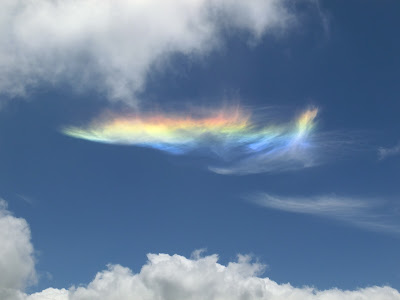Courtesy of Lise Brandhagen
Picture courtesy of Mark Coates
Iridescence is produced by a physical mechanism called diffraction, which is associated with the wavelike nature of light. Light is bent around the corners of particles or through holes and gaps in them. The amount of bending depends on the wavelength of light, with different colors having different wavelengths (shorter for purple and blue, longer for yellow and red). These diffraction effect creates the colors you see.
Perhaps the most impressive iridescence occurs in lenticular clouds, with the look totally other worldly (see below). No wonder some folks thought they were UFOs!
I should note that the diffraction mechanism in iridescent clouds is different than the way colors are produced in rainbows, which separate the colors when light is bent entering and leaving materials (like a prism).
Where did the term iridescence come from? The technical term for the phenomenon is irisation, which in turn reflects that role of the greek goddess Iris, who was the goddess of rainbows. She also delivered messages from the gods to mortals.
Finally, let me note that I appreciate the picture folks send me and enjoy answering your weather questions. This blog is one of my major main tools for outreach and public education (the other is KNKX) and your emails and pictures make it a two-way interaction--which makes it more fun and meaningful for all of us.









I thought that the splitting of the light in a cirrus was the same as in sun dogs, with the light going through prismatic crystals. I guess the primary splitting apart of the colors is primarily due to diffraction because the droplets or crystals in the cirrus are so much smaller and so much closer together than those in rain? I think I read that the explanation for sun dogs is due to ice crystals acting like little prisms. I have seen colored sun dogs. So if I understand right, there are THREE mechanisms for the separation of light by wavelength in the sky: Prismatic splitting by ice crystals, splitting as the light goes through curved droplets, and diffraction.
ReplyDeleteIncidentally, I may have said this before, but you can create your own rainbow: Stand with the sun at your back, but where the background in front of you is shaded, as by a tree. Take a garden hose and adjust the nozzle for a very fine spray, with the sunlight illuminating the spray. You will see a rainbow if you get the angles right.
Hi Cliff, longtime reader and fan. I particularly have a passion for atmospheric optical phenomena. I would have identified the top three photos as a circumhorizontal arc. The third and faintest image is debatable but I'd say the top two are definitely CHAs. Can you clarify how you differentiate iridescence from ice halos, when you have to rely solely on photos for identification?
ReplyDeleteI tend to guess iridescence as occurring when the light source is near or behind the cloud. Colors are not well organized, irregular, and muted. Les Cowley identifies iridescence as occurring frequently in "altocumulus, cirrocumulus and especially in lenticular clouds". The iridescence you show in the lenticular clouds is a great example because the bands of color are randomly sized and most colorful at the edges, with near-white appearing in the thickest part of the cloud. It's because of the varying intensity and faintness that the third image might be iridescence.
The CHA is reliably identifiable when a spectrum appears horizontally in the presence of cirrus clouds. In the first two examples especially the individual colors are regularly sized and the color doesn't vary much across the cloud; it's a strong arc of color. Sun proximity helps too, which is why it drives me a little nuts when someone crops a photo tightly and gives no reference for the sun position.
Those top two photos (Lise's and the Create Commons image) both look like Circumhorizontal Arcs to me. These arcs are a summer phenomenon for us in the Pacific Northwest (due to our latitude and the elevation of the Sun) and can be incredibly vibrant! Check out the amazing Atmospheric Optics website https://www.atoptics.co.uk/halo/cha2.htm to see more cool photos and explanations about the ice crystal shapes that produce them.
ReplyDeleteYour outreach is very helpful to me and I suspect the community too, Cliff!
ReplyDeleteThanks Cliff -- what is the appropriate email to use for sending you such questions/pictures?
ReplyDeleteNice work and thoughts on this website as always!
ReplyDeleteNow I understand how Pink Floyd's "Dark Side of the Moon" album cover originated.
ReplyDeleteHow about the chemtrail conspiracy? How could those jet contrails not be chemtrails?
ReplyDeleteI agree with Emily and Walter that the top two shots are probably from ice crystals.
ReplyDeleteIn general, the circumzenithal arc is the more common source of that rainbow-like band, the circumhorizontal much less so. My first guess was the circumzenithal, but it depends on the time of day the photo was shot. The sun is often higher in the sky now, making the CZ a bit less likely.